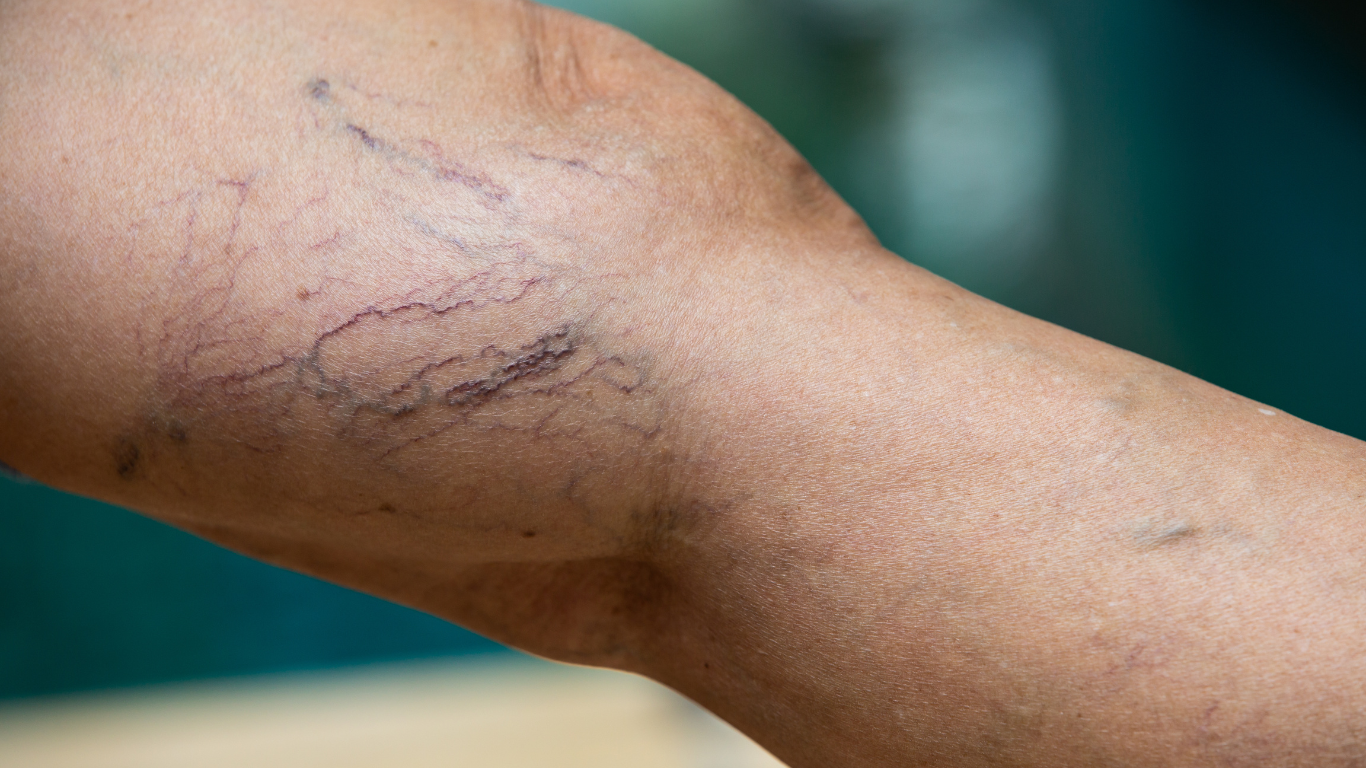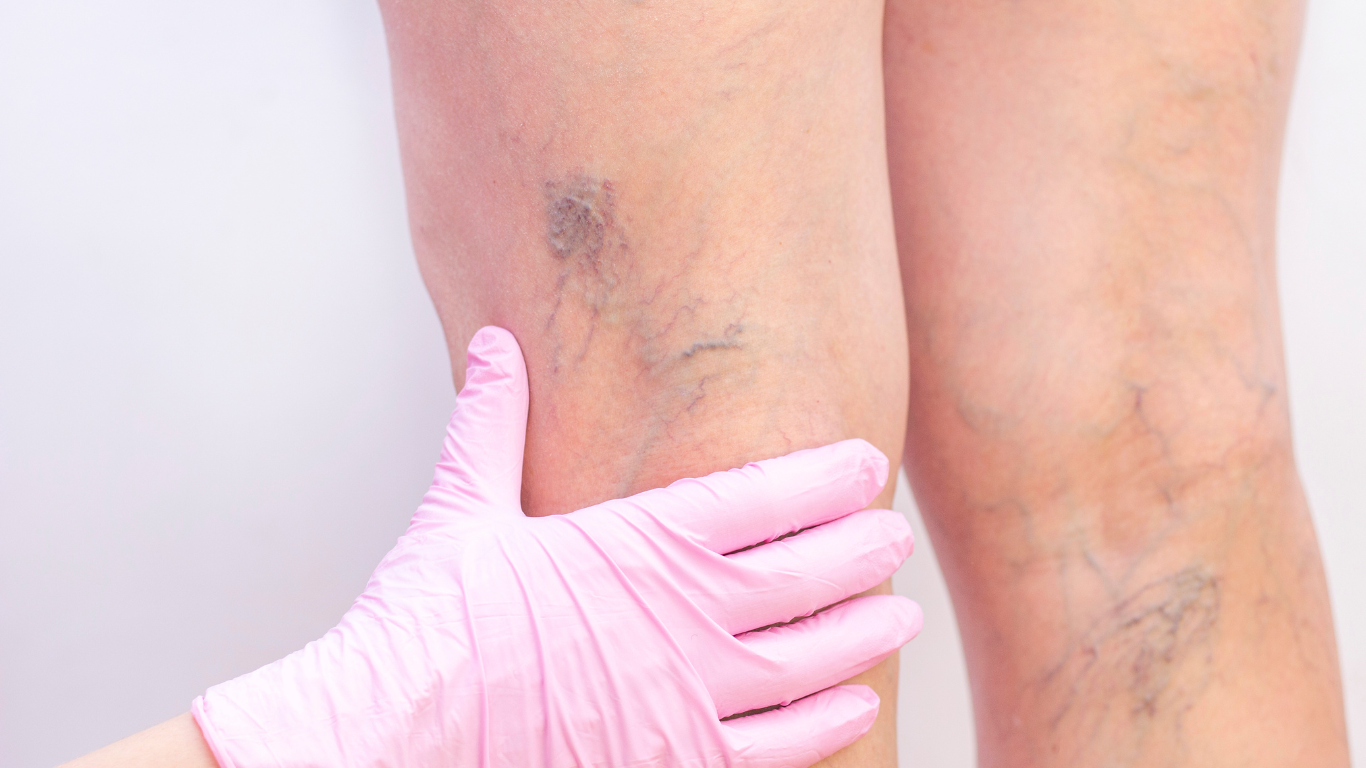Spider Veins

What are Spider Veins
Spider veins, also known as telangiectasias, are small, twisted blood vessels that appear near the surface of the skin, resembling spider webs or tree branches. These veins are typically red, blue, or purple in color and are often a cosmetic concern rather than a health issue. Spider veins develop when the valves within the veins weaken, causing blood to pool and the veins to dilate. While they are generally harmless, they can be unsightly and may cause mild discomfort. Spider veins commonly appear on the legs, particularly on the thighs, calves, and ankles. However, they can also manifest on the face, especially around the nose and cheeks. Understanding the common areas where spider veins occur is essential for individuals who may be dealing with this cosmetic concern, as it helps guide preventive measures and potential treatment options. If you have questions or concerns about spider veins, consulting with a Dermatologist can provide personalized advice based on your specific situation.
What Causes Spider Veins
factors. One key contributor to their development is a genetic predisposition, meaning if your family members have had them, you might be more prone to developing them too. Age plays a role as well, as the veins tend to lose elasticity over time. Hormonal changes, especially in women during pregnancy or menopause, can increase the likelihood of spider veins due to hormonal fluctuations affecting blood vessels. Lifestyle factors, such as prolonged periods of standing or sitting, obesity, and a lack of physical activity, also contribute. These veins result from weakened valves in the blood vessels, causing blood to pool and veins to dilate. Understanding these factors can help individuals take preventive measures and make lifestyle adjustments to minimize the risk of developing spider veins. If you’re concerned about spider veins, consulting with a dermatologist can provide personalized insights and guidance on managing or treating this common condition.
Spider veins often present with distinct symptoms that can help in their identification. Common signs include the appearance of small, twisted blood vessels near the skin's surface, forming patterns reminiscent of spider webs or tree branches. These veins are typically red or purple and are most commonly found on the legs and face. Spider veins are generally harmless and do not cause any discomfort. Identifying spider veins involves noting their characteristic appearance, which includes visible clusters of tiny veins. When it comes to recognizing these veins, paying attention to any unusual red or blue discoloration on the skin, especially on the legs, can be crucial. If you notice these symptoms or experience any discomfort, it's advisable to consult with a healthcare professional for a thorough evaluation and guidance on potential preventive measures or treatments. Understanding the symptoms and how to identify spider veins empowers individuals to take proactive steps in managing this common cosmetic concern.
Several risk factors contribute to the likelihood of developing spider veins, and understanding them can help individuals take proactive steps in prevention. Gender plays a role, with women being more prone to spider veins than men, possibly due to hormonal changes during pregnancy, menstruation, or menopause. Family history also plays a significant role, as a genetic predisposition can increase the likelihood of developing these veins. Additionally, certain occupations that involve prolonged periods of standing or sitting, such as nursing or office jobs, can contribute to the risk of spider veins. Other factors, like obesity and a lack of physical activity, may further elevate the likelihood. By recognizing these risk factors, individuals can adopt lifestyle modifications and preventive measures to minimize the chances of developing spider veins. If you fall into one or more of these risk categories or are concerned about your vein health, consulting with a healthcare professional can provide personalized insights and guidance on maintaining healthy veins
Preventing the onset of spider veins involves incorporating simple yet effective lifestyle adjustments. Maintaining a healthy weight through a balanced diet and regular exercise can significantly reduce the risk of developing these veins. Exercise, such as walking or swimming, promotes healthy blood circulation and strengthens the muscles that support the veins. It's crucial to avoid prolonged periods of sitting or standing, as both can contribute to poor blood circulation. Taking breaks to stretch or walk during extended periods of sitting can make a substantial difference. Elevating the legs when resting can also help alleviate pressure on the veins. Additionally, wearing compression stockings can provide support and promote better blood flow. By adopting these preventive strategies, individuals can take proactive steps in maintaining optimal vein health and reducing the likelihood of developing spider veins. If you have concerns or questions about vein health, consulting with a healthcare professional can offer personalized advice based on your specific circumstances.
At FCP Dermatology we offer a wide range of surgical and cosmetic Dermatology services, in a 5-star luxury setting.
- +1 (416) 861-8600
- Contact Us
Spider Veins Treatment
Related Body Concerns
View Available Treatments
Treating Spider Veins
How To Get Rid of Spider Veins
When it comes to addressing spider veins, various cosmtic treatments can effectively minimize their appearance. Sclerotherapy is a widely used procedure where a solution is injected directly into the veins, causing them to collapse and fade over time. Laser therapy, including advanced technologies like the Excel V+, uses targeted light energy to break down spider veins, promoting their gradual disappearance. Both treatments are considered safe when performed by an experienced physician and minimally invasive, providing effective results for many individuals. While these procedures can significantly improve the appearance of spider veins, it’s essential to consult with a dermatologist to determine the most suitable approach based on individual circumstances. Understanding available cosmetic treatments empowers individuals to make informed decisions about managing spider veins and achieving optimal vein health. If you’re considering these treatments, a consultation with a dermatologist can offer personalized insights and guidance.
Exploring self-care practices is a valuable approach for individuals looking to manage the appearance of spider veins at home. Regular exercises, such as walking or cycling, can promote healthy blood circulation and strengthen the muscles supporting the veins. Leg elevation, where the legs are raised above heart level when resting, can help reduce pressure on the veins. Compression stockings are key to prevent the appearance of spider veins. While these home remedies may not eliminate spider veins entirely, they can certainly enhance vein health. It's important to note that consulting with a dermatologist is advisable for a comprehensive understanding of individual needs and potential treatment options. Incorporating these self-care practices into your routine empowers you to actively contribute to the well-being of your veins and overall health.
Spider Veins Treatment
When to Seek Professional Help
Knowing when to seek professional help for spider veins is crucial for effective management and personalized guidance. If you experience an increase in the number and visibility of spider veins, it’s advisable to consult a dermatologist. Additionally, if you have a family history of vein issues or if you’re considering cosmetic treatments, seeking professional advice is essential. A dermatologist can conduct a thorough evaluation, considering your medical history and potential contributing factors. They may recommend appropriate treatments, ranging from lifestyle modifications and self-care practices to cosmetic interventions like sclerotherapy or laser therapy. Seeking professional help ensures that you receive tailored advice based on your unique circumstances, promoting optimal vein health and addressing any concerns you may have about spider veins. For more information and answers to common questions about spider veins, a dermatologistl can provide valuable insights and guidance.

Spider Veins Treatment FAQ
Frequently Asked Questions about Spider Veins
Spider veins are small, dilated blood vessels near the skin's surface.
Spider veins are small, dilated blood vessels near the skin's surface caused by weakened valves. Genetics and lifestyle factors can contribute.
Spider veins are smaller, closer to the skin, and typically don't cause as much discomfort as varicose veins.
While lifestyle changes can help manage symptoms, professional treatments are often needed for effective elimination.
Yes, aging can weaken vein valves, increasing the likelihood of spider veins.
Typically spider veins have no symptoms.
Diagnosis involves a physical examination.
No, spider veins dont cause pain.
Exercise, leg elevation, and compression stockings, but professional treatments may be necessary.
Sclerotherapy is a minimally invasive procedure where a solution is injected to collapse spider veins, and it's generally effective.
Laser therapy uses targeted light energy to break down spider veins, promoting their gradual disappearance.
Hormonal changes, such as those during pregnancy or menopause, can increase the risk of
spider veins.
In most cases, spider veins are not a sign of a serious health problem but consulting a healthcare professional is recommended.
Yes, hormonal changes and increased pressure on veins during pregnancy can contribute to spider veins.
Healthy lifestyle habits like regular exercise, maintaining a healthy weight, and avoiding prolonged sitting can reduce the risk.
Yes, they can reoccur, and ongoing preventive measures may be needed.
Complications may include discomfort, skin changes, or, rarely, the development of more severe venous issues.
Professional treatments are often needed for effective management.
